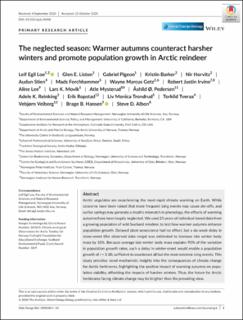The neglected season: Warmer autumns counteract harsher winters and promote population growth in Arctic reindeer
| dc.contributor.author | Loe, Leif Egil | |
| dc.contributor.author | Liston, Glen E. | |
| dc.contributor.author | Pigeon, Gabriel | |
| dc.contributor.author | Barker, Kristin | |
| dc.contributor.author | Horvitz, Nir | |
| dc.contributor.author | Stien, Audun | |
| dc.contributor.author | Forchhammer, Mads C. | |
| dc.contributor.author | Getz, Wayne M. | |
| dc.contributor.author | Irvine, Robert Justin | |
| dc.contributor.author | Lee, Aline Magdalena | |
| dc.contributor.author | Movik, Lars K. | |
| dc.contributor.author | Mysterud, Atle | |
| dc.contributor.author | Pedersen, Åshild Ønvik | |
| dc.contributor.author | Reinking, Adele K. | |
| dc.contributor.author | Ropstad, Erik | |
| dc.contributor.author | Trondrud, Liv Monica | |
| dc.contributor.author | Tveraa, Torkild | |
| dc.contributor.author | Veiberg, Vebjørn | |
| dc.contributor.author | Hansen, Brage Bremset | |
| dc.contributor.author | Albon, Steve D. | |
| dc.date.accessioned | 2021-03-26T12:43:44Z | |
| dc.date.available | 2021-03-26T12:43:44Z | |
| dc.date.created | 2020-12-16T19:02:48Z | |
| dc.date.issued | 2020 | |
| dc.identifier.issn | 1354-1013 | |
| dc.identifier.uri | https://hdl.handle.net/11250/2735752 | |
| dc.description.abstract | Arctic ungulates are experiencing the most rapid climate warming on Earth. While concerns have been raised that more frequent icing events may cause die-offs, and earlier springs may generate a trophic mismatch in phenology, the effects of warming autumns have been largely neglected. We used 25 years of individual-based data from a growing population of wild Svalbard reindeer, to test how warmer autumns enhance population growth. Delayed plant senescence had no effect, but a six-week delay in snow-onset (the observed data range) was estimated to increase late winter body mass by 10%. Because average late winter body mass explains 90% of the variation in population growth rates, such a delay in winter-onset would enable a population growth of r = 0.20, sufficient to counteract all but the most extreme icing events. This study provides novel mechanistic insights into the consequences of climate change for Arctic herbivores, highlighting the positive impact of warming autumns on population viability, offsetting the impacts of harsher winters. Thus, the future for Arctic herbivores facing climate change may be brighter than the prevailing view. body mass, climate change, fitness, GPS, movement ecology, plant phenology, Rangifer, snow, space use, ungulates | en_US |
| dc.language.iso | eng | en_US |
| dc.rights | Navngivelse 4.0 Internasjonal | * |
| dc.rights.uri | http://creativecommons.org/licenses/by/4.0/deed.no | * |
| dc.title | The neglected season: Warmer autumns counteract harsher winters and promote population growth in Arctic reindeer | en_US |
| dc.type | Peer reviewed | en_US |
| dc.type | Journal article | en_US |
| dc.description.version | publishedVersion | en_US |
| dc.source.journal | Global Change Biology | en_US |
| dc.identifier.doi | 10.1111/gcb.15458 | |
| dc.identifier.cristin | 1860727 | |
| dc.relation.project | Norges forskningsråd: 267613 | en_US |
| cristin.ispublished | true | |
| cristin.fulltext | original | |
| cristin.qualitycode | 2 |

